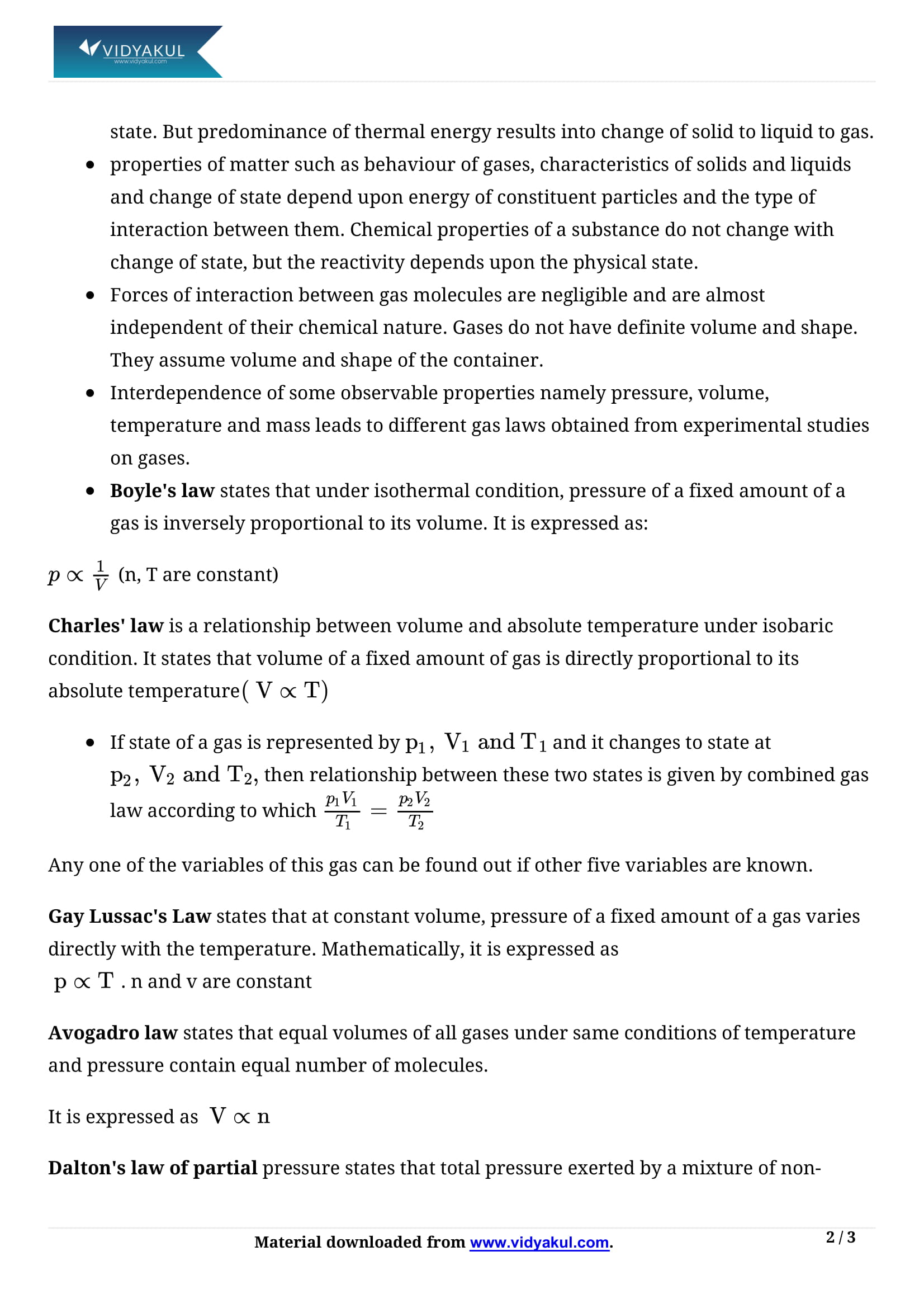States of Matter Class 11 Notes

Chapter 5 States of Matter
Chapter 5 of NCERT Chemistry for Grade 11 deals with states of matter. This chapter covers important topics such as properties and behavior of gases and liquids. Also includes mathematical calculations and graphical representations. NCERT notes are aligned with the latest programs. Therefore, students can refer to these materials to begin their preparation.
NCERT notes Chapter 5 for Class 11 Chemistry is prepared with detailed step-by-step solutions. As a result, students can start their education accordingly. Because States of Matter is an important chapter, students have free access to all study materials on Vidyakul. So, scroll down to read more about this chapter.
CBSE 11th CHEMISTRY CH-5
Points to Remember
Students can learn more important points about the States of Matter from below:
Solid is the state of matter which has a definite shape and a definite volume. Liquid has a definite volume but no definite shape. Gas has neither definite shape nor definite volume.
Dipole-dipole, dipole-induced dipole and dispersion forces are collectively van der Waals forces.
Gay Lussac’s law: At constant volume, pressure of a fixed amount of a gas varies directly with the temperature.
The chapter deals with a wide range of laws.
Average speed is the arithmetic mean of the speeds of different molecules.
Topics and Sub-Topics
The state of matter is a subject familiar to students. Students learn the basic concepts of this chapter in elementary school. When the core concepts are clear, students can easily score high marks. You will also have no problems working out concepts. NCERT notes for Class 11 Chemistry Chapter 5 is a great way to study for the exam.
Students can access learning resources on Vidyakul to get started. Students are also required to use materials such as Vidyakul explainers and 3D videos.
Hence, students can focus on each unit or subtopic to kickstart their preparation. Students must know what they are learning. As a result, learning will become very easy. Hence, students can get the Vidyakul Exemplars and start their preparation.
Frequently Asked Questions
What is Charle’s Law?
Charles’s law states that the volume occupied by a fixed amount of gas is directly proportional to its absolute temperature, if the pressure remains constant
What is an ideal gas equation?
The ideal gas equation is formulated as: PV = nRT. In this equation, P refers to the pressure of the ideal gas, V is the volume of the ideal gas, n is the total amount of ideal gas that is measured in terms of moles, R is the universal gas constant and T is the temperature.
What is intermolecular space?
Intermolecular spaces can be defined as the space between two molecules or atoms.
Practice Questions
Given: Quantity of gas = 4.0 mol occupies 5 dm3, Pressure = 3.32 bar, R = 0.083 bar dm3 K-1 mol-1.
Calculate the molar mass of phosphorous with the following details:
The quantity phosphorus vapour is 34.05 mL, and weight is 0.0625 g. At 0.1 bar pressure and 546 °C temperature.
What is the physical importance of van der Waals parameters? Explain.
Solid is the state of matter which has a definite shape and a definite volume. Liquid has a definite volume but no definite shape. Gas has neither definite shape nor definite volume.
Dipole-dipole, dipole-induced dipole and dispersion forces are collectively van der Waals forces.
Gay Lussac’s law: At constant volume, pressure of a fixed amount of a gas varies directly with the temperature.
The chapter deals with a wide range of laws.
Average speed is the arithmetic mean of the speeds of different molecules.
What is Charle’s Law?
What is an ideal gas equation?
What is intermolecular space?
Given: Quantity of gas = 4.0 mol occupies 5 dm3, Pressure = 3.32 bar, R = 0.083 bar dm3 K-1 mol-1.
Calculate the molar mass of phosphorous with the following details:
What is the physical importance of van der Waals parameters? Explain.
Learn more about in States of Matter Class 11 Notes pdf.
Download this solution for FREE Download this PDF






